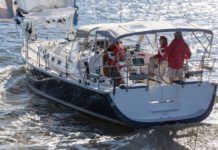It’s likely that someone has already calculated your boat’s stability. Since 1998 all boats sold in the EU were required to have stability data calculated. Additionally, US Sailing (www.ussailing.org) maintains lists for one-designs and common boats. The easiest place to find certificates is through the Offshore Racing Congress (www.orc.org). Nevertheless, we know there are curious types who drawn to the idea of collecting their own numbers.
Heeling the boat with a line to the mast is one way to measure the forces required to heel your boat. And, although you can’t (and shouldn’t) roll the boat, you can lay it down pretty far if you have enough room.

This approach comes with a number of risks. If a line comes loose while the boat is severely heeled at the dock, the boat can snap roll up wards very rapidly, swinging wildly, slamming into the dock, and damaging other boats within range of the mast. Move the boat away from other boats and the dock.
Use the spinnaker halyard. It is designed for side loading and should be safely strong enough to put the mast in the water. A well-maintained rig should be strong enough to take this sort of use without damage. When estimating rigging loads, sparmakers and riggers will use this method to heel the boat to around 30-degrees.
If lines tied to docks are used to winch the mast down, remember that docks are not designed to take upward loads. We know of one sailor who, instead of going up the mast to retrieve a lost halyard, decided to heel the boat over until he could reach it. When the boat was heeled about 30 degrees, the dock decking lifted free and swung into the boat, ripping out lazy jacks and putting a kink in a shroud. The mast hit a neighboring boat, damaging that standing rigging as well. Of course, there were bad feelings all around.
The ORC uses this procedure to collect initial data to be fed into a computer program. The computer, using hull shape, appendage, and other details provided by the designer, then generates the entire stability curve. However, without the required software and precision measuring equipment, you’re not likely to learn anything useful that you can’t learn from some of the other methods described in the adjacent article. We recommend against attempting this without oversight of a rigger or engineer.

































